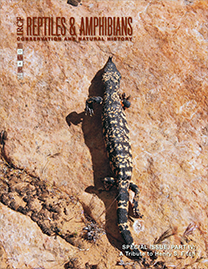Some Natural History Notes on the Brooding Behavior and Social System of Two Oklahoma Skinks, Plestiodon fasciatus and Plestiodon obtusirostris
DOI:
https://doi.org/10.17161/randa.v17i4.16123Abstract
The purpose of this study was to quantify the social and reproductive behavior of Plestiodon fasciatus and P. obtusirostris. We conducted laboratory experiments with brooding behavior and field experiments to test for mate-guarding and territoriality. To determine the use of space by both species, we conducted a mark-recapture study. We constructed two permanent 1-ha trapping grids of can pitfall traps and cover-boards, with an inter-trap distance of 10 m. One was in a mixed woodland-grassland habitat and one in a grassland habitat. We manipulated the hydric environment to determine parental behavior of brooding female P. obtusirostris. We size-matched male P. fasciatus and P. obtusirostris for dyadic encounters with and without females and both on and off home ranges in order to determine social behavior. Change in hydric conditions did not induce female P. obtusirostris to move eggs to more suitable nest sites in our experiments. Plestiodon fasciatus exhibited behavior associated with mate-guarding. Plestiodon obtusirostris did not display behavior associated with territoriality, and our experiment examining mate-guarding calls for a more intensive study.
Metrics
Downloads
Published
Issue
Section
License

This work is licensed under a Creative Commons Attribution-NonCommercial 4.0 International License.
Copyright is held by the authors. Articles in R&A are made available under a Creative Commons Attribution-NonCommercial 4.0 International license.

